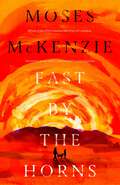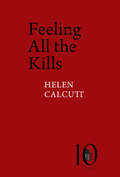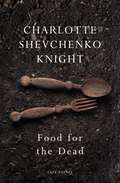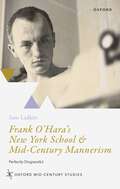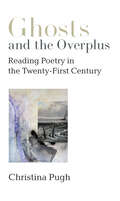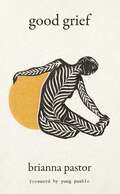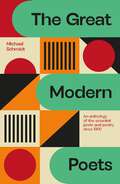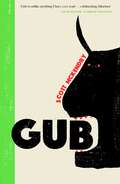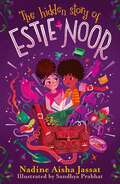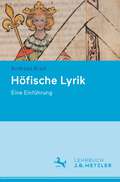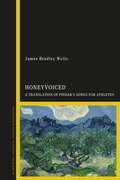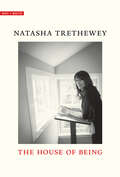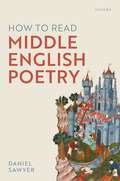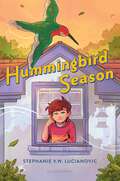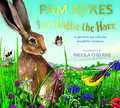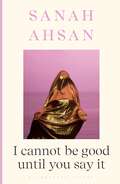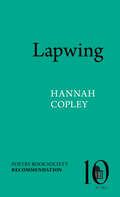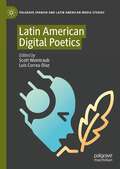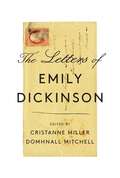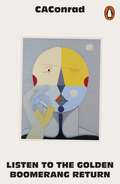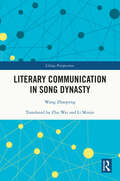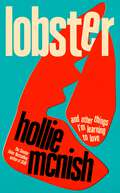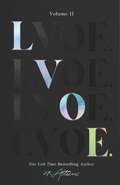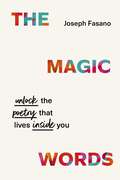- Table View
- List View
Fast by the Horns: The hotly anticipated second novel from the prizewinning author of An Olive Grove in Ends
by Moses McKenzieFrom the Hawthornden Prize-winning author of An Olive Grove in Ends, a powerful story of broken dreams and divided loyaltiesBristol, 1980. In the tight-knit neighbourhood of St. Pauls, 14-year-old Jabari is proud of his position as the only son of revered community leader Ras Levi. Raised in a world of sus laws and council neglect, Jabari finds hope in his Rastafari faith, which offers the comforting vision that one day he and his fellow believers will repatriate to the motherland, where they will at last be free from oppression and prejudice.But in St Pauls a local firebrand activist has been arrested, and violence soon overflows, pulling both father and son into its maelstrom. As Jabari rages against the iniquity, a chance encounter with a young Black child gifts him an opportunity for justice - or is it revenge?Praise for An Olive Grove in Ends:'Tough yet tender' Observer - 10 Best Debut Novelists of 2022''Luminous' Cherie Jones'Moses' talent is off the scale' Donal Ryan'Remarkable' Nathan Harris'Consummately crafted' Patrick McCabe
Feeling All the Kills (Pavilion Poetry)
by Helen CalcuttFeeling All the Kills is a dazzling new collection that breaks the poet’s silence on what it means to experience and live in the wake of a violent assault and rape. Calcutt weaves stunning musicality with raw, unhindered storytelling, as the poems both collectively, and in their individual power, explore the distinctly connected, yet fractured selves of ‘sexual being’, ‘mother’ and ‘abused person’. Through the poems’ breathtaking and vital vocabulary Calcutt brings the physical, emotional, and sexual nuances of life to the foreground, with strength, subtlety and beauty, and courageously harnesses a sense of ownership over such a lasting trauma. At the heart of this collection is a personal desire to navigate a way back to a sensual, whole-feeling self, to shamelessly ‘feel all’ -- with authenticity and power.
Food for the Dead: ‘Beautiful and necessary’ Ilya Kaminsky
by Charlotte Shevchenko Knight**WINNER OF AN ERIC GREGORY AWARD**This searingly powerful first collection about Ukrainian identity is a howl of anguish and an elegant counter-song against totalitarianism'A beautiful, necessary book'ILYA KAMINSKY, author of Deaf Republic'Every poem is a masterpiece'OLIA HERCULES, author of MamushkaWith this searingly powerful first collection, Charlotte Shevchenko Knight gives the current war in Ukraine some much-needed human focus, while examining its brutal aggression within a wider and more accurate historical context.Central to this book is ‘a timeline of hunger’, a lyric sequence which examines the legacy of the Holodomor (‘death by hunger’ in Ukrainian) – Stalin’s man-made famine of the 1930s. This long poem opens in Kyiv in 2021 – ‘brief visitations / of appetite / I devour / beetroot / its juices / running / down my lips / blood / of the past’ – and closes in Donetsk in 1929: ‘we burst the balloon / skin of tomatoes / between our teeth / seeds running down chins / like confetti / & we already know / every meal / should be celebrated.’ Through the poet’s sensitive approach to the historical, moving from that genocide of the early 1930s, then on through the Second World War, the Chornobyl disaster, to modern-day invaded Ukraine, we understand that within their ‘bones Holodomor / lives on’.Both a howl of anguish and an eloquent counter-song against totalitarianism, this is a book about invasion, war, destruction and death, but also about the bonds of humanity, family and a history of oppression – about staying alive while always hungry.
Frank O'Hara's New York School and Mid-Century Mannerism: Perfectly Disgraceful (Oxford Mid-Century Studies Series)
by Sam LadkinFrank O'Hara's New York School and Mid-Century Mannerism offers a ground-breaking account of the poet Frank O'Hara and the extraordinary cultural blossoming O'Hara catalysed, namely the mid-century experimental and multi-disciplinary arts scene, the New York School. Fresh accounts of canonical figures (Jackson Pollock, Willem de Kooning, George Balanchine, Fred Astaire) and original work on those too little discussed (Edwin Denby, Elaine de Kooning) resound with analysis of queer iconology from Michelangelo's David to James Dean. Sam Ladkin argues that O'Hara and the New York School revive Mannerism. Turning away from interpretations of O'Hara's Transcendentalism, Romanticism, or pastoralism, 'mid-century Mannerism' helps explain O'Hara's self-conscious style, its play with sweet and grand grace, contortion of conventional measure, risks with affectation, conceits, nonchalance, and scrambling of high/low culture. Mannerism clarifies the sociability implicit in the formal innovations of the New York School. The work also studies the kinship between art mediums by retooling rhetoric and recovering a perennial manneristic tendency beyond period style. Genealogies of grace, the figura serpentinata, sprezzatura, ornatus, and the marvellous exemplify qualities exhibited by O'Hara's New York School. Ladkin relates the essential role of dance in the New York School. O'Hara's reception has been tied to painting, predominantly Abstract Expressionism. He was also, however, a balletomane, a fan, for whom ballet was 'made up exclusively of qualities which other arts only aspire to in order to be truly modern.' Relaying ballet's Mannerist origins and aesthetics, and demonstrating its influence alongside Broadway and Hollywood musical-dance on art and poetry, completes the portrait of mid-century modernity.
Ghosts and the Overplus: Reading Poetry in the Twenty-First Century (Poets On Poetry)
by Christina PughGhosts and the Overplus is a celebration of lyric poetry in the twenty-first century and how lyric poetry incorporates the voices of our age as well as the poetic “ghosts” from the past. Acclaimed poet and award-winning teacher Christina Pugh is fascinated by how poems continually look backward into literary history. Her essays find new resonance in poets ranging from Emily Dickinson to Gwendolyn Brooks to the poetry of the present. Some of these essays also consider the way that poetry interacts with the visual arts, dance, and the decision to live life as a nonconformist. This wide-ranging collection showcases the critical discussions around poetry that took place in America over the first two decades of our current millennium. Essay topics include poetic forms continually in migration, such as the sonnet; poetic borrowings across visual art and dance; and the idiosyncrasies of poets who lived their lives against the grain of literary celebrity and trend. What unites all of these essays is a drive to dig more deeply into the poetic word and act: to go beyond surface reading in order to reside longer with poems. In essays both discursive and personal, Pugh shows that poetry asks us to think differently—in a way that gathers feeling into the realm of thought, thereby opening the mysteries that reside in us and in the world around us.
Good Grief
by Brianna Pastor'Brianna Pastor is by far one of my favourite new writers. If you want to feel seen and deeply moved, read Good Grief. Let the power of her writing guide you to a better life.' Yung Pueblo, #1 New York Times bestselling authorAn expanded edition with over forty brand-new poems of the bestselling poetry collection Good Grief by Brianna Pastor.When Brianna Pastor released her self-published poetry collection, Good Grief, she was blown away by the outpouring of support from people who reached out and said, 'Yes. Me too.' For anyone who has struggled with questions of identity or coped with serious emotional issues, including grief, trauma, anxiety and depression, this collection will help you find hope on the other side.We don't know how long our pain will last. we assume that because it hurts now, it is probably going to hurt tomorrow. it may even hurt the next day. perhaps it will get worse. but we sleep, and you see, and we do this marvellous thing in our sleep - we mend. And tomorrow is not always what we thought it would be. From Good Grief
The Great Modern Poets: An anthology of the essential poets and poetry since 1900
by Michael SchmidtAn essential introduction to the most significant poems and their works since 1900Reproduced within this collection are some of the greatest poems of the 20th century, featuring works from major writers such as T.S. Eliot and Sylvia Plath to Langston Hughes and W.B. Yeats. For each, Michael Schmidt provides an insight into their themes and the background to their work, opening for the reader a deeper understanding and enjoyment of these extraordinary poems.Poets include:W.B. YeatsRobert FrostEdward ThomasPhilip LarkinT.S. EliotTed HughesLangston HughesSylvia PlathC.S SissonDerek WalcottEzra Pound& many more!
Gub
by Scott McKendry'Gub is unlike anything I have ever read. In a playful demotic that is exhilarating, hilarious and never forced, Scott McKendry makes magic of a Belfast that in other hands would make grim reading. The most exciting poet to come out of the north of Ireland in many years' Louise Kennedy, author of Tresspasses'There is nothing else like this in Irish poetry. A lyrical savant of the highest level, and one of the most exciting writers in Ireland today, McKendry is utterly his own beast' Michael Nolan, author of Close To Home'A distinctive and energetic voice' Sunday Times IrelandDemons, geese, The Laughing Cow, marching bands, LSD and pistols smuggled home from the USSR. You'll find all these in Scott McKendry's GUB. Rooted in the language of working-class Belfast, and slipping between eras and time zones, closing the gap between the real and the fantastical, the academic and the everyday, the parish and the polis, McKendry's exhilarating debut collection comes to terms with generational trauma, social decay and the rituals of a place with a fraught history and an uncertain future. Invoking the balaclava'd gunmen, urban warlords and explosions which gripped the decades either side of the Good Friday Agreement, GUB drags the language of ghettoised Belfast into serious Irish poetry. Wearing the lyrical influences of his 'ugly city' lightly - Carson, McGuckian, Longley - McKendry's tightly-wrought structures weave an unprecedented verse of mourning, witness, alter ego, class alienation and aesthetic turmoil. Noisy, dark and witty, GUB is an utterly new voice out of Belfast, but one posting bulletins across inner-city neighbourhoods everywhere.
The Hidden Story of Estie Noor
by Nadine Aisha JassatNo one wanted to hear Estie's side of the story. Now she's on a mission to make sure the truth is heard . . . A page-turning mystery novel in verse about identity, friendship and learning to use your voice, with accessible text and beautiful illustrations throughout. When twelve-year-old Estie is expelled from school, she's sent to stay with her aunt in Scotland over the summer. Even though nobody, not even her mum, asked to hear her side of the story. Estie's determined to keep her barriers up and stick to herself until the holidays are over. But when she comes across an intricately folded paper castle with a secret message written inside - a message from someone desperate to tell their own unbelieved story - a chord is struck, and Estie can't help but follow the clues to the next piece of artwork. Who are these messages from? And what will their secret reveal about the town? In helping to uncover the anonymous artist's truth, Estie just might find the words to tell her own. . .
Höfische Lyrik: Eine Einführung
by Andreas KraßMinnesang, Sangspruch und Leich – die drei Hauptgattungen der deutschsprachigen Lyrik des Hochmittelalters stehen im Zentrum dieser Einführung. Der erste Teil behandelt die kulturgeschichtlichen und politischen Voraussetzungen sowie die form- und gattungsgeschichtlichen Entwicklungen. Ein besonderes Augenmerk liegt dabei auf der kulturellen Konstruktion der Geschlechterrollen und Liebeskonzepte. Der zweite Teil bietet zahlreiche Interpretationen zu konkreten Fallbeispielen aus allen drei Gattungen der höfischen Lyrik und führt so in die Praxis der Textanalyse ein. Kapitel zur Überlieferungs- und Editionsgeschichte sowie ein weiterführendes Literaturverzeichnis runden den Band ab.
HoneyVoiced: A Translation of Pindar’s Songs for Athletes
by Dr James Bradley WellsThis new translation of Pindar's songs for victorious athletes marries philological rigour with poetic sensibility in order to represent the beauty of his language for a modern audience as closely as possible. Pindar's poetry is synonymous with difficulty for scholars and students of classical studies. His syntax stretches the limits of ancient Greek, while his allusions to mythology and other poetic texts assume an audience that knows more than we now possibly can, given the fragmentary nature of textual and material culture records for ancient Greece. It includes an authoritative introduction, both to the poet and his art and to ancient athletics, alongside brief orientations to the historical context and mythological content of each victory song. The inclusion of a glossary supplies additional mythological and historical information necessary to understanding Pindar's poetry for those coming to the works for the first time. His is the largest body of textual remains that exists for ancient Greece between Homer (conventionally dated to 750 BCE) and the Classical Period (480–323 BCE), and constitutes a rich resource for politics, history, religion, and social practices.
The House of Being (Why I Write)
by Natasha TretheweyAn exquisite meditation on the geographies we inherit and the metaphors we inhabit, from Pulitzer Prize winner and nineteenth U.S. poet laureate Natasha Trethewey “Searching and intimate, this impresses.”—Publishers Weekly In a shotgun house in Gulfport, Mississippi, at the crossroads of Highway 49, the legendary highway of the Blues, and Jefferson Street, Natasha Trethewey learned to read and write. Before the land was a crossroads, however, it was a pasture: a farming settlement where, after the Civil War, a group of formerly enslaved women, men, and children made a new home. In this intimate and searching meditation, Trethewey revisits the geography of her childhood to trace the origins of her writing life, born of the need to create new metaphors to inhabit “so that my story would not be determined for me.” She recalls the markers of history and culture that dotted the horizons of her youth: the Confederate flags proudly flown throughout Mississippi; her gradual understanding of her own identity as the child of a Black mother and a white father; and her grandmother’s collages lining the hallway, offering glimpses of the world as it could be. With the clarity of a prophet and the grace of a poet, Trethewey offers up a vision of writing as reclamation: of our own lives and the stories of the vanished, forgotten, and erased.
How to Read Middle English Poetry
by Daniel SawyerHow to Read Middle English Poetry guides readers through poetry between 1150 and 1500, for study and pleasure. Chapters give down-to-earth advice on enjoying and analyzing each aspect of verse, from the choice of single words, through syntax, metre, rhyme, and stanza-design, up to the play of larger forms across whole poems. How to Read Middle English Poetry covers major figures?such as Chaucer, Langland, the Pearl Poet, and Robert Henryson?but also delves into exciting anonymous lyrics, romances, and drama. It shows, too, how some modern poets have drawn on earlier poems, and how Middle English and early Scots provide crucial standpoints from which to think through present-day writing. Contextual sections discuss how poetry was heard aloud, introduce manuscripts and editing, and lay out Middle English poetry's ties to other tongues, including French, Welsh, and Latin. Critical terms are highlighted and explained both in the main text and in a full indexed glossary, while the uses of key tools such as the Middle English Dictionary are described and modeled. References to accessible editions and electronic resources mean that the book needs no accompanying anthology. At once thorough, wide-ranging, and practical, How to Read Middle English Poetry is indispensable for students exploring Middle English or early Scots, and for anyone curious about the heart of poetry's history.
Hummingbird Season
by Stephanie V.W. LucianovicA poignant and necessary story about finding hope during difficult times, set in the early days of the Covid-19 pandemic.Archie's life--and the whole world--is turned upside down by Covid-19. Suddenly there are no more Friday night dinners out, no more going to school, no more hanging out with friends . . . no leaving the house at all. Even though he's inside with his family all day every day, Archie can't help but feel more alone than ever before. While everyone else seems to be adapting to their new normal just fine, it's like Archie is permanently on mute, unable to find the words to describe how he feels--and sometimes, unable to find someone who will listen. The bright spot of Archie's days at home is watching and learning about the hummingbirds that feed outside his windows. But just when it seems like this could be what brings his family together again, California experiences its worst wildfire in history, and Archie's favorite hummingbird disappears. In a time when hope is hard to hold on to, Archie must find his voice and find hope once again.Hummingbird Season is an honest and healing novel in verse documenting the early days of the Covid-19 pandemic and the things that bring us together when circumstances keep us apart.
I am Hattie the Hare: A tale from our wild and wonderful meadows
by Pam AyresJoin Hattie the playful Brown Hare as she leaps from meadow to farm to heath, in this heartwarming tale written in rhyme by the much-loved poet Pam Ayres, author of The Last Hedgehog.We didn’t always live here, once we had a sunny home,We came here with centurions, all the way from Rome . . .From grape green meadows to old-fashioned farms, hares travelled thousands of miles to find a home in the British countryside. What do they eat? What's their perfect habitat? Can you tell them apart from rabbits?Wonderfully illustrated by award-winning artist Nicola O'Byrne, I Am Hattie the Hare is a follow-up to the bestselling I Am Oliver the Otter. Bursting with natural and historical facts interwoven throughout the story, and with an information spread at the end that includes tips on where to spot these gentle animals.
I cannot be good until you say it
by Sanah AhsanThe much-anticipated debut collection by the winner of the Outspoken Performance Poetry Prize: a tender meditation on queerness and Islam'Dissolving whatever boundaries would wall us off from love, Ahsan finds a way to let it all be holy' Victoria Adukwei-Bulley'When I speak of the word "sacred", Sanah Ahsan's I cannot be good until you say it will forever instantly spring to mind ... A masterpiece - an honour to have read this book, I am forever changed after reading its beauty' Nikita Gill'Innovative and deeply compassionate ... multilingual verse suffused with a vital musicality and a palpable tenderness, Ahsan calls poetry into prayer and evokes a faith safe enough to be mothered by' Mary Jean Chan'Dexterous, varied, erotic, filled with rage, worships and wonder ... I am electrified' Pádraig Ó Tuama'Tensions of psychological drama, together with an induced sense of yearning.. what an artful and inspired set of poems' Anthony Anaxagorou'Liberation is at the nucleus of every page of Sanah Ahsan's rousing debut ... Ahsan is doing liberation work, offering readers a prayer, a song, a hand to hold amidst the amidst' Kaveh Akbar'A remarkable and transformative collection' Keith Jarrett'A daring debut collection, which guides us through the complexities of just being' Yomi Sode'Alive with a want and restlessness that remakes the "You" of desire - and faith - again and again' Will Harris'A heart punching debut collection' Raymond Antrobus______________________________________________Intricately weaving Quranic verse, psychology, and the hip-hop soundtrack of their childhood, Sanah's poems reach for divinity in the body; an archive that refuses erasure.These poems traverse unruly emotional and physical landscapes, Whiteness, islamophobia, homophobia, intergenerational suffering, and the politics of therapeutic processes. In these pages, belief and unbelief, goodness and badness, the material and spiritual are intertwined, reclaiming queer love and desire as holy.How are we incarcerated by others' gazes? Who gets to be good in a society built upon hierarchy? How might we embrace each other's madnesses? Sanah Ahsan asks questions that travel to the heart of our humanness, bending the lines between psychologist and client to show us the sacred nature of our wounds. These poems kneel to the messiness of being alive, building altars to complication and presence. Refusing binaries of gender or religious doctrine, I cannot be good until you say it finds what is to be revered in the grey spaces of morality, advancing imagination and self-compassion as sites of communion.This debut collection is a call to prayer, fearlessly complicating what is good, and what is god.
Lapwing (Pavilion Poetry)
by Hannah CopleyPoetry Book Society Recommendation Summer 2024 Migrating across voices and blurring the divide between bird and human, self and other, Hannah Copley’s Lapwing explores restlessness, love, and ecological and personal grief in a vivid and incantatory sequence of poems. A lyrical biography of a bird and a fragmented study of a flawed and mutable creature bearing its name, Copley’s second collection takes inspiration from John Gower’s brid falseste of alle and its many literary guises. At the heart of the book are the shifting figures of Lapwing and Peet, two creatures whose overlapping narratives echo the double note of the bird’s cry. In Lapwing, known by countless names, migratory, and slowly disappearing beneath addiction, Copley examines a life in a slow tumble, as we are transported into a world shaped by real and imagined predators. Running alongside Lapwing is the searching voice of Peet, a daughter left to understand her father’s vanishing while trying to make a life in a habitat no longer fit for survival. Bold, exacting, and deeply personal, Copley’s poems call out from empty nests, drained wetlands, and ploughed fields to create a soundscape of endangerment and wonder. *Lapwing *asks that we consider how, like the bird itself, we must all dissemble to survive.
Latin American Digital Poetics (Palgrave Spanish and Latin American Media Studies)
by Scott Weintraub Luis Correa-DíazLatin American Digital Poetics seeks to take the pulse of emergent poetic forms whose history is entangled with the computational and its AI dreams and achievements. This study carefully and thoroughly probes the intersection between the literary, the cultural, and the scientific-technological in order to reflect on the ways that digital technology has radically reshaped and reconfigured nearly all aspects of contemporary culture. The main idea of this book, then, is simple: by way of panoramic approaches to digital poetry as well as select case studies, we seek to account for the multi-directional exchange between poetry, technology, and culture via a (primarily) pedagogical approach.
The Letters of Emily Dickinson
by Emily DickinsonThe definitive edition of Emily Dickinson’s correspondence, expanded and revised for the first time in over sixty years.Emily Dickinson was a letter writer before she was a poet. And it was through letters that she shared prose reflections—alternately humorous, provocative, affectionate, and philosophical—with her extensive community. While her letters often contain poems, and some letters consist entirely of a single poem, they also constitute a rich genre all their own. Through her correspondence, Dickinson appears in her many facets as a reader, writer, and thinker; social commentator and comedian; friend, neighbor, sister, and daughter.The Letters of Emily Dickinson is the first collected edition of the poet’s correspondence since 1958. It presents all 1,304 of her extant letters, along with the small number available from her correspondents. Almost 300 are previously uncollected, including letters published after 1958, letters more recently discovered in manuscript, and more than 200 “letter-poems” that Dickinson sent to correspondents without accompanying prose. This edition also redates much of her correspondence, relying on records of Amherst weather patterns, historical events, and details about flora and fauna to locate the letters more precisely in time. Finally, updated annotations place Dickinson’s writing more firmly in relation to national and international events, as well as the rhythms of daily life in her hometown. What emerges is not the reclusive Dickinson of legend but a poet firmly embedded in the political and literary currents of her time.Dickinson’s letters shed light on the soaring and capacious mind of a great American poet and her vast world of relationships. This edition presents her correspondence anew, in all its complexity and brilliance.
Listen to the Golden Boomerang Return
by CA ConradThe new collection from 'one of America's most legendary living poets' (Ocean Vuong), written in the drive to fall in love with the world again not as it was, but as it iswhen the hammerapproached we thought is that thing coming this wayBreathing, moving, living on the page, CAConrad’s exhilarating work is centred on the (Soma)tic ritual, their celebrated practice which draws on nature, crystals, meditation and interactions with strangers to create an ‘extreme present’ of unfettered creativity from which poems can emerge.Listen to the Golden Boomerang Return gathers the results of a single new ritual, focused on fellow animals who have found ways to thrive in the Anthropocene, and spanning environments from Seattle – a city built in the midst of an abundant nontropical rainforest – to the Mojave Desert. The poet receives gifts from a crow; associates different parts of their body with nine different species encountered in the desert; and joins a woman each morning in feeding rats in the streets of Rome, taking turns looking out for the police.Written with urgency, hope, anger and joy, the poems that result are an ode to survival in a world that humanity has poisoned, and a testament to a love that knows no by-laws.
Literary Communication in Song Dynasty (ISSN)
by Wang ZhaopengBased on first-hand historical materials, this book explores the various aspects of literary communication during the Song Dynasty in China.The book investigates the single-channel dissemination of poetry and ci works, the dissemination of literary collections, the dissemination through wall inscriptions, the oral dissemination of Song ci, the remuneration and commercialization of literature in the Song Dynasty, the paths to fame for Song writers, the non-literary factors in the dissemination of literature and the dissemination of literary works through paintings and songs. The author provides insights into the six major questions in the study of literary communication: Who disseminates, where, how, what, to whom and the effects of dissemination. The author also seeks to provide detailed answers to the following questions. What was the role of female singers in both domestic and official entertainment? What were the costs and prices of the books? Who paid the authors? What methods did writers use to gain fame and social recognition?This work will be essential reading for scholars and students of Chinese studies, communication studies and media and cultural studies.
Literary Communication in Song Dynasty (ISSN)
by Wang ZhaopengBased on first-hand historical materials, this book explores the various aspects of literary communication during the Song Dynasty in China.The book investigates the single-channel dissemination of poetry and ci works, the dissemination of literary collections, the dissemination through wall inscriptions, the oral dissemination of Song ci, the remuneration and commercialization of literature in the Song Dynasty, the paths to fame for Song writers, the non-literary factors in the dissemination of literature and the dissemination of literary works through paintings and songs. The author provides insights into the six major questions in the study of literary communication: Who disseminates, where, how, what, to whom and the effects of dissemination. The author also seeks to provide detailed answers to the following questions. What was the role of female singers in both domestic and official entertainment? What were the costs and prices of the books? Who paid the authors? What methods did writers use to gain fame and social recognition?This work will be essential reading for scholars and students of Chinese studies, communication studies and media and cultural studies.
Lobster: and other things I’m learning to love: 'energising, fearless and joyful' Sara Pascoe
by Hollie McNishA brand-new collection from the award-winning poet, the companion piece to the Sunday Times bestselling Slug'Funny, so smart and refreshingly honest' SARAH MILLICAN'Hollie McNish's words always sweep me away' GIOVANNA FLETCHERThis book is written out of both hate and love for the worldAs people, we are capable of both love and hate; amazement and disgust; fun and misery. So why do we live in a world that is constantly telling us to hate, both ourselves and others? We are told to be repulsed by our own bodies, bodies that let us laugh and sweat and eat toast; to be ashamed of pleasure; to be embarrassed by fun. In this collection, Hollie McNish brings her inimitable style to the question of what have been taught to hate, and if we might learn to love again.'Never have we needed her more' STYLIST'I've loved her work for years' JO BRAND'She writes with honesty, conviction, humour and love' KAE TEMPEST
LVOE II
by AtticusIn the highly anticipated follow-up to LVOE: Poems, Epigrams & Aphorisms, three-time New York Times bestselling author Atticus is inviting readers to take a deeper look behind the mask as he continues his powerful journey inward in search of love, peace, and acceptance.LVOE. Volume II is an expanded exploration of self-love, meditation, meaning, loss, and romance from the internet's favourite poet. Atticus implores his instantly recognizable lyrical style, gorgeous illustrations, and relatable themes to once again dazzle readers, inspiring them to look within. This collection will feature all-new poems, each paired with beautiful sketches that bring the words alive from the page.LVOE. Volume II looks forward, backward, but most importantly inward to the often confusing yet hopeful human experience.
The Magic Words
by Joseph FasanoDiscover the joy of expressing what’s inside you, with fill-in-the-blank poems that are sparking a creative movement.We all have stories inside us, whether or not we consider ourselves ‘creative’. And with these 50 simple fill-in-the-blank poems, anyone can write poetry, whatever age or ability. By adding just a few words of your own, you create something beautiful and wholly new that comes from within.Discover the magic of putting your feelings into words and be inspired by sample poems submitted by people of all ages and walks of life. Exploring themes like friendship, love, grief, gratitude, and hope, these inclusive, accessible, and deceptively simple poems express powerful emotional truths, written by you.Discover the joy of expressing what’s inside you, with fill-in-the-blank poems that are sparking a creative movement
